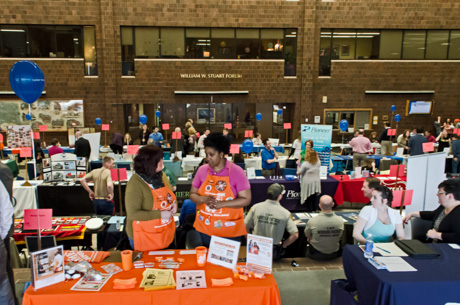UPDATED 5:33 p.m. with comments from Steve Hyde.
While Genesee County Economic Development Center officials boast of 1,500 jobs created in the past five years, Department of Labor statistics don't show anything near that rate of job growth.
In 2005, according to labor statistics, there were 23,000 non-farm jobs in Genesee County; in 2010, there were also 23,000.
Since 2001, Genesee County has seen a net gain of 100 non-farm jobs.
That said, during the 2009/2008 recession, Genesee County fared better than the rest of the nation. While Genesee County lost 2.5 percent of its jobs from 2008 to 2010, as a whole the United States shed 5.1 percent of its jobs.
"Considering the past recession (Genesee County's job growth) numbers don’t look so terrible to me," said Tammy Marino, a researcher with the NYS Department of Labor based in Rochester. "They look reasonable compared to the rest of nation."
She added, "(The GCEDC) has probably done good job of bringing new jobs into the community, but it’s hard to see just because of the past recession, what we’ve been through in the past two years."
Steve Hyde, CEO of the EDC, said a lot of what his agency does is just try "stem the tide of decline" sweeping New York State.
"You look at the last 10 years and everyone around the country is shedding jobs and there are 100 more jobs in a recessionary environment than we had 10 years ago, on a relative basis, that’s a win for Genesee County," Hyde said. "New York is ranked the 50th most difficult state to do business in. Until we have systemic change in tax policy and and regulation policy, we're fighting hard just to buffer the tide of decline."
It's also hard, Hyde said, to compare DOL statistics with an EDC's job commitment numbers. Companies that get tax abatement and other assistance make a commitment to create a certain number of jobs over a four-year time frame. When the EDC says it created 1,500 jobs over the past five years, some of those jobs are still in the pipeline and wouldn't show up in labor statistics.
"We're working with companies working to grow or retain jobs," Hyde said. "What we're really trying to do is (incentivize) investments because when investment occurs by a company, it will create a long-term tax base and it builds roots in the community, which will lead to long-term job creation."
District 8 Legislator Hollis Upson, who sits on the GCEDC board, said just looking at the raw numbers doesn't tell the full story of job creation in Genesee County.
"There's an awful of variables there and I don't know how to reconcile the Department of Labor statistics," Upson said. "If the EDC is creating jobs, they don't make any assumptions or have knowledge of jobs that might have been depleted. We (the county) might have lost 1,500 jobs."
In looking at job growth over the past 10 years, two sectors of employment for Genesee County stand out: Manufacturing, which has lost 800 jobs, and government, which has gained 700 jobs.
Marino said that Genesee County and the entire Rochester region is not immune from what is going on in the rest of the nation. Manufacturing jobs are being lost to free trade and greater efficiency driven by improved technology in factories.
"It doesn’t mean the existing companies are are not viable," Marino said. "But more manufacturers are taking advantage of technology to get more output with fewer workers. That trend has especially hit the metro area. We've had very steep job losses in the most recent years."
Genesee County has probably lost manufacturing jobs, just like the rest of the nation, Upson said, as it competes with China and other nations.
"Even Mexico is complaining now about losing jobs to China," Upson said. "Capital will flow to where the labor is cheaper."
But in the end, Upson said, a job is a job.
"We strive for those (manufacturing jobs)," Upson said. "We like those better then anything because they have the best ripple effect."
But, he added, New York is a mighty hard place to recruit manufacturers. He called New York punitive and overregulated.
"Even though manufacturing jobs would be the nice ones to attract, they are very difficult to do so given the umbrella we're working under in the State of New York," Upson said.
It's that climate that led to the EDC changing its public name about 10 years ago from Genesee Industrial Development Agency to Genesee County Economic Development Center, Upson said.
Genesee County's employment peaked in 2008 at 23,600 non-farm jobs.
The labor department tracks the county's jobs on a monthly basis, and online statistics go back 21 years. For this story, we're using the annual monthly average.
Looking at monthly comparisons, however, in a January-over-January match from 2010 to 2011, statistics show Genesee County picking up 300 jobs, from 21,600 to 21,900.
Typically, there are more jobs in Genesee County during summer months. In August 2010, there were 23,800 jobs.
Over the past 21 years, the biggest month for non-farm jobs was June 2009 when Genesee County boasted 25,100 jobs.
Meanwhile, new unemployment statistics released this week show the county's unemployment rate rose from 7.9 percent in December to 9 percent in January. A year ago in January, unemployment was 9.6 percent.
As for the county's jump in government workers, Morino speculated that while schools have probably added staff, especially the community college, a lot of Genesee County's government job growth is probably driven by the presence of a Federal Detention Center and a Homeland Security office.
In fact, most of the county's government job growth came in 2002 and 2003 in the wake of the 9/11 attacks.
Western New York, Morino said, tends to remain pretty stable in both good and bad economic times.
"We don’t see any extreme highs and extreme lows," she said. "During the past recession, the auto industry was hit very hard and we didn’t see any of that because we’re not really dependent on the auto industry. Also, housing prices remained stable. We didn’t see that big build up in housing values, and didn’t see them fall either."





